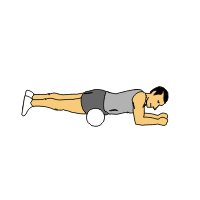Form
Before we get into the actual SMRT exercises we need to discuss form. Form is always of critical importance when performing any exercise. Be aware of your body positioning and alignment. For example, when lying on your side make sure your elbow is directly under your shoulder. Poor alignment and improper placement on the foam roller can lead to injury. Also, remember to breathe deeply while performing SMRT.
Pressure
There are several ways to increase or decrease the amount of pressure we place on a trigger point. To increase pressure, for example, in the hamstring technique you would remove one leg off the roller. You can also use a denser (harder) foam roller.
Duration
I try to spend at least a minute rolling while I'm noting any trigger spots I feel. Then I locate the trigger point and hold pressure on the spot for 30 seconds to 1 minute. This can seem like an eternity when you're feeling pain, however, the pain should decrease as you hold the position. The pain should be what I can only describe as a "working pain" and definitely not anything near excruciating. Rule of thumb: Listen to your body. You should feel better after SMRT, not worse.
Contraindications
Last, but not least, it's important to note that some experts suggest SMRT is appropriate when pain or inflexibility is present, but should be reduced or stopped once the issue has resolved. In addition, SMRT is contraindicated in certain situations including, but not limited to, a recent injury, circulatory problems, pregnancy, osteoporosis and hypertension. Always check with your medical professional before beginning any exercise program.
Types of Foam Rollers
I prefer the longer roller because I can also use it for balance and stability exercises that require me to lay on it. You may prefer the shorter roller for ease of transport. Be aware of the various foam densities and textures. Click here for foam roller options.
SMRT exercises:
SMRT for Hamstrings
- Position the back of the upper thigh on the roller.
- Make sure that your hands are placed directly under the shoulders.
- If your wrists are uncomfortable you can raise up on your knuckles and straighten the wrists.
- Roll until you find a trigger point(s). Hold until you feel a reduction in pain. Breathe. Release.
- To increase pressure place one leg on top of the other.
- To decrease pressure put one foot on the floor.
SMRT for Quadriceps
- Lay face down with the front of the upper thigh on the roller.
- Position elbows directly under the shoulders. Make sure your neck is aligned with your spine.
- Maintain core strength. Think of drawing your navel in toward the spine.
- Roll forward and back extending down the length of your thigh to the top of your knee until you locate a trigger point(s). Hold. Breathe. Release.
SMRT for Illiotibial Band
- This particular SMRT can be particularly painful for some. If this is the case remember to adjust the pressure as needed.
- Lay on your side with your upper thigh on the roller.
- Make sure your elbow is directly under your shoulder.
- Keep the neck aligned with your spine.
- Roll from the top of the thigh down to just above the knee until you locate a trigger point(s). Hold for 1-2 minutes. Breathe. Release and roll.
Sources:
http://www.optp.com/Foam-Roller-Therapy.aspx
animations from:
http://www.sport-fitness-advisor.com/self-myofascial-release.html




